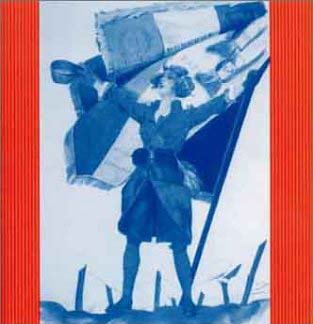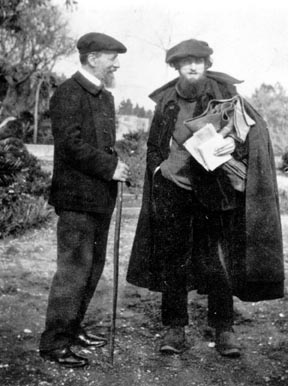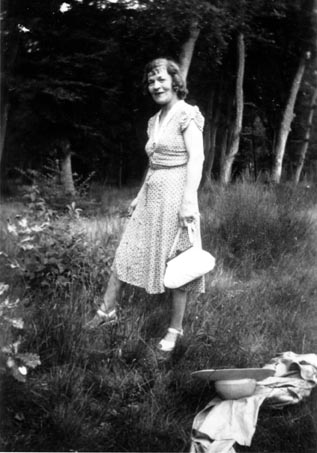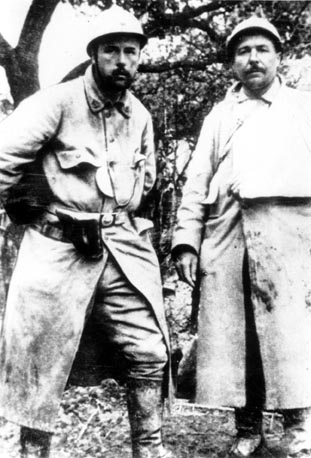Nancy Sloan Goldberg, Ph.D.
 Professor of French, Emerita
Professor of French, Emerita
Department of World Languages, Literatures and Cultures
Middle Tennessee State University
Nancy.Goldberg@mtsu.edu ; https://orcid.org/0000-0003-3970-7700
French Writers of the Great War
Écrivains français de la Grande Guerre
Although Henri Barbusse's Le Feu (Prix Goncourt 1916), Roland Dorgeles' Les Croix de bois, (Prix Fémina 1919), and Georges Duhamel's La Vie des Martyres, 1917 and Civilisation 1914-1917 (Prix Goncourt 1918) remain the best-known examples of French writing on the Great War, many other writers published significant novels, poetry, and plays during the war era. The following paragraphs delineate my work on pacifist poets, women novelists, and other French writers of the Great War, many of whom have slipped into obscurity. It is my hope that this site will help to bring them the recognition they deserve.
During the Great War, there was much anxiety about the steadfastness of the home front's support, and the rallying cry "On les aura!" soon gave way to a nervous "Pourvu qu'ils tiennent!" Thus, from the earliest days of the war, the French government called upon writers and intellectuals to use their skills to guide and influence public opinion. Poets and novelists flooded the bookstores and newspapers with war-related verse, novels, essays, and plays, including Paul Géraldy's best-seller of 1916, La Guerre, Madame, Histoire de Gotton Conixloo by Camille Mayran, winner of the Grand Prix du Roman in 1918, Mathilde Démians d'Archimbaud's A travers le tourment: une vie intime, winner of the Prix Jules Davaine in 1917, as well as Gaspard by René Benjamin, and La Flamme au poing by Henry Malherbe, respective winners of the Prix Goncourt in 1915 and 1917. Even the famed Spanish novelist Vicente Blasco Ibáñez responded directly to the call by French President Raymond Poincaré. His world-wide bestseller Los Quatro Jinettes del Apocalipsis is the subject of my essay “Nationalism, Sin, and Redemption in The Four Horsemen of the Apocalypse and its American Film Adaptations” in Mnemosyne and Mars: artistic and cultural representations of Twentieth-Century Europe at War, (ed. Peter Tame).
The novels of two of these soldier-writers, Jean Valmy-Baysse and Roland Dorgelès, center on the demobilization and the difficult realities veterans faced in their social reintegration. In Le Retour d’Ulysse (1921) and Le Réveil des morts (1923), Valmy-Baysse and Dorgelès respectively recount the fraud and hostility of civilians that awaited the returning polius, rather than the warmth and gratitude they anticipated. (See my essay "Gratitude: A Different Kind of War Reparation." Lingua Romana 13.1).
These works, the product of their authors’ direct witness, were enshrined with moral authority and ownership of the truth concerning the war. In "From Barbusse to Lemaitre: The Evolution of Experience." Anglica 27.3, I examine how the passage of time forced a shift in an understanding of témoignage and created an opportunity for post-memory writers, especially in genre fiction, to retrieve absent or absented topics.
Écrivaines
Women of letters, too, registered their talents in service to the nation. During the period 1914-1919 (censorship ended in October, 1919), many of France's best-known contemporary female authors and scholars produced a substantial number of non-fiction (histories, economic analyses, scientific reports, essays, and personal narratives) as well as a large collection of war-centered fiction, in the various forms of poetry, short stories, and novels. While these authors were critically-acclaimed and certainly prolific, their names and works are largely forgotten now. In Woman, Your Hour is Sounding: Continuity and Change in French Women’s Novels of the Great War, I examine more than forty of the novels and short stories published during the war era and analyze how these writers used fiction to voice their perception of the war's impact on women and their understanding of the personal and social transformations taking place as they wrote. See author list below. In "Women, War and H. G. Wells: the Pacifism of French Playwright Marie Lenéru," War, Literature and the Arts , 14, I examine the British writer's internationalist proposals and their interpretation in Lenéru's antiwar play, La Paix, written in 1917. My essay, "French Women Poets Respond", contained in the collection, Beyond Modern Memory: The Literature of the Great War Reconsidered, (ed. Patrick Quinn and Steven Trout), analyzes concepts of love as poetic vehicles to express attitudes about the war in the poems of Anna de Noailles, who supported the war, Noélie Drous and Henriette Sauret, both opposed, and Cécile Périn, whose views on the war fluctuated. The chapter, " Les Femmes, le civil, et le soldat dans les romans de la Grande Guerre" in the collection Les Femmes Écrivent la Guerre, (ed. Frédérique Chevillot and Anna Norris), analyses how women and men of letters, including Colette Yver, Henri Barbusse, Lucie Delarue-Mardrus, Roland Dorgelès, and Camille Marbo (pseudonym of Marguerite Borel), understood the integration of patriotism and social critique, especially of women's behavior during the war. Borel's leadership and importance in the recruitment, training, and retention of women war workers are examined in "Marguerite Borel/ Camille Marbo: the government's feminist," included in French and francophone women facing war/Les Femmes face à la guerre, (ed. Alison S. Fell). The essay “Qui donc fermera la porte entr’ouverte?”: the Home and the Nation in Women’s War Poetry” in Essays in French Literature and Culture. 51, continues my work on French war poetry with an analysis of the competing themes of foyer and patrie in the texts of some two dozen women poets, including Jean Balde (Jeanne Alleman), Jeanne Perdriel-Vaissière, Hélène Picard and Marie-Paule Salonne (see below)
Despite the government's call to writers to aide the war effort, did any French writers raise their pens to stem the tide of militarism sweeping Europe? From the earliest days of the war, Romain Rolland, the best-known living French author, opposed the war, and his essays in Le Journal de Genève, beginning with "Au-dessus de la mêlée" (1914) brought him both intense admiration and derision. As the lone public voice against the war, Rolland inspired and encouraged others to emulate his courageous stance, and despite the danger due to censorship during the war, many responded through poetry and correspondence. This poetry figures in my "' Une grande âme n'est jamais seule' : la reception poétique contemporaine d'Au-dessus de la mêlée" in Centenaire d'Au-dessus de la mêlée de Romain Rolland. (ed. Landry Charrier and Roland Roudil). While few people today are familiar with these or any of the vast number of works which bore witness to the increasing opposition to the Great War, antiwar poets participated in the energetic campaign to galvanize public opinion for peace. They attempted to transmit a distinct historical moment by the means they knew best: poetry. Their imagery is rich and intense, their language vibrant and burning with the clarity of vision and purpose. My En l’honneur de la juste parole: la poésie française contre la Grande Guerre, remains the most complete analysis and presentation of French verse written by more than fifty-five poets in opposition to the First World War. (A fewcopies still available. Please contact me for details.)
Influences: Hugo, Wagner, Tolstoy and Whitman; the Abbaye de Créteil
For many of these poets, their antiwar stance launched long and distinguished careers in French letters. For others, like Charles Vildrac and Henri Guilbeaux, the war provided the catalyst for the expansion of a humanist-based aesthetic devoted to the unification of life and art and the blending of the real and ideal. Inspired by a love of Hugo, Wagner, Tolstoy, and Whitman and fueled by the activities of contemporary socialists and anarchists, an entire generation of young creative people defined beauty as the symbiosis of the physical and spiritual presence of the community of humankind. My essay, "Charles Vildrac: Nothing is Lost from a Loving Heart," published in Focus on Robert Graves and His Contemporaries, situates Vildrac's war poetry within his understanding of art as the most perfect expression of modern life. His war-era poetry presents a multifaceted, synthetic consciousness of war, yet remains concerned with the beauty of language and the energy of experience. While Vildrac emphasized the power of the individual to actualize a harmonious universe, Henri Guilbeaux turned toward the more collective means of action envisioned by trade unionists and communists. In "From Whitman to Mussolini: Modernism in the Life and Works of a French Intellectual," published in the Journal of European Studies (XXVI, 1996) an analysis of Guilbeaux's poetry and activism illuminates the modernist fusion of aesthetics and social change. Two other essays examine the translation into action of this unified view of life and art by those opposed to the Great War. In "Nietzsche contre Hugo: l’Individu, la Communauté et l’Abbaye de Créteil," published in Studi Francesi . (XLVI, 2000), I investigate the first published poems (1905-1908) of the famed Abbaye writers: Georges Duhamel, Charles Vildrac, and René Arcos, in the context of their shared communal living experience with fellow artists Albert Doyen, Albert Gleizes, Henri-Martin Barzun, and Alexandre Mercereau. In "Unanimism in the Concert Hall: Les Fêtes du Peuple, 1919-1939," (The French Review 65.5.), I examine composer Albert Doyen's community-centered effort to democratize the experience of art by drawing on the untapped energy of factory workers and others traditionally excluded from musical performance.
Antiwar Writers and Artists
- René Arcos
- Georges Bannerot
- Lucien Banville
- Charles Baudouin
- Nicolas Beauduin
- Charles Bernard
- Charles Désiré Berthold-Mahn
- Joseph Billiet
- Gaston Bornstein
- Loïs Cendré
- Georges Chennevière
- Paul Colin
- Eugène Dabit
- Henri Dalby
- Eugene Camille Délong (Genold)
- Albert Doyen (et Les Fêtes du peuple)
- Noélie Drous
- Georges Duhamel
- Édouard Dujardin
- Luc Durtain
- Noël Garnier
- Genold (Eugène Camille Délong)
- André Germain
- Albert Gleizes
- Ivan Goll
- Edmé Goyard
- Henri Guilbeaux
- Pierre Hamelryckx
- Lucien Jacques
- Pierre Jean Jouve
- Paul Lantelme
- Pierre Larivière
- Marc de Larréguy (de Civrieux)
- Marcel Lebarbier
- Jean Lunaire
- Marcel Martinet
- Frans Masereel
- Henry de Montherlant
- Cécile Périn
- Charles Picart Le Doux
- Georges Pioch
- Maurice Pottecher
- Jean-Michel Renaitour
- Romain Rolland
- Jules Romains
- Jean de Saint-Prix
- Claude Salives (Claude le Maguet)
- Jean-Paul Samson
- Henriette Sauret
- Marcel Sauvage
- Paul Vaillant-Couturier
- Alfred Varella
- Théo Varlet
- Emile Verhaeren
- Madeleine Vernet
- P.-J. Vidi
- Charles. Vildrac
Women Authors
- Aurel
- Hortense Barrau
- Lya Berger
- Berthem-Bontoux
- Jean Bertheroy
- Marguerite Borel (Camille Marbo)
- Marthe Borély
- Jeanne Broussan-Gaubert
- Jack de Bussy
- Marcelle Capy
- Hortense Cloquié
- Colette
- Louise Compain
- Comtesse de Courson
- Élie Dautrin
- Lucie Delarue-Mardrus
- J. Delorme Jules-Simon
- Mathilde Démians d’Archimbaud
- Noélie Drous
- Geneviève Duhamelet
- Odette Dulac
- Mary Floran
- Louise-Amélie Gayraud
- Gyp
- Th. Harlor
- Gérard de Houville
- Marie de La Hire
- Jeanne Landre
- Marie Laparcerie
- Marie Lenéru
- Camille Marbo
- Andrée Mars
- M. Maryan
- Camille Mayran
- Jehanne d' Orliac
- Mme Yves Pascal
- Yvonne Pitrois
- Rachilde
- Marie Reynès-Monlaur
- Isabelle Sandy
- Maria Star
- Marcelle Tinayre
- Tony d' Ulmès
- Pauline Valmy
- Madeleine Vernet
- Henriette de Vismes
- Colette Yver
- Louise Zeys
Poets
- Jean Balde
- Baronne de Baye
- Adrienne Blanc-Péridier
- S. Boutet-Lagrée
- Marguerite Burnat-Provins
- Henriette Charasson
- Virginie Demont-Breton
- Noélie Drous
- Marguerite Duportal
- Madeleine Le Chevrel
- Marie Le Franc
- Amélie Murat
- Berthe de Nyse
- Jeanne Perdriel-Vaissière
- Cécile Périn
- Hélène Picard
- Marie-Paule Salonne
- Henriette Sauret
- Louise Simard
- Jeanne Valcler
- Madeleine Vernet





